Tidal effects on hydrostatic leveling system used in high precision alignment of particle accelerator∗
2014-03-07XUShaoFeng许少峰HEXiaoYe何晓业CHENXiaoDong陈晓东HUANGXianLiang黄显良andLANGXiaoLing郎孝龄
XU Shao-Feng(许少峰),HE Xiao-Ye(何晓业),, CHEN Xiao-Dong(陈晓东), HUANG Xian-Liang(黄显良),and LANG Xiao-Ling(郎孝龄)
1NSRL,University of Science and Technology of China,Hefei 230029,China
2Institute of Geodesy and Geophysics,Chinese Academy of Sciences,Wuhan 430077,China
3Anhui Seismological Bureau,Hefei 230031,China
4Jingxian Seismostation,Xuancheng 242500,China
Tidal effects on hydrostatic leveling system used in high precision alignment of particle accelerator∗
XU Shao-Feng(许少峰),1HE Xiao-Ye(何晓业),1,CHEN Xiao-Dong(陈晓东),2HUANG Xian-Liang(黄显良),3and LANG Xiao-Ling(郎孝龄)4
1NSRL,University of Science and Technology of China,Hefei 230029,China
2Institute of Geodesy and Geophysics,Chinese Academy of Sciences,Wuhan 430077,China
3Anhui Seismological Bureau,Hefei 230031,China
4Jingxian Seismostation,Xuancheng 242500,China
Hydrostatic leveling system(HLS)is widely used in precision engineering survey,especially the alignment of particle accelerator,and the tidal effects on the measurement accuracy of HLS is non-ignorable,thus studies on tidal effects on the HLS is vital.A set of HLS was installed in Jingxian seismostation for verifying the methods to handle the tidal effects on the readings of HLS.Harmonic analysis of the data recorded by HLS and DSQ water tube clinometers in Jingxian seismostation and contrastive analysis of the results are completed. The tilt tide can be well reflected in the data of the both instruments and the results are both reliable.The reasons of the difference between the results are analyzed in this paper.Besides,a validation study based on the measurement data of the HLS used in SPring-8 storage ring for tidal correction on the reading of HLS is completed.The research establishes a foundation for HLS to be applied in micron-level precision alignment of particle accelerator in the future.
Precision engineering survey,Hydrostatic leveling system,Tilt tide,DSQ water tube clinometers,Harmonic analysis
I.INTRODUCTION
A hydrostatic leveling system(HLS),based on the principle that the liquid(deionized water or purified water)in the HLS is always looking for an equipotential surface,uses connected reservoirs of water to determine elevation difference at the locations of HLS[1].Fig.1 brie fl y represents the measuring principle of HLS,among which h1,h2,h3represent the data collected from each sensor,thus the height difference Δh1and Δh2can be described as Eq.(1):

HLSs are applied in CERN(Switzerland),ESRF(France), DESY(Germany),Fermilab(USA),BEPC II(China),SLAC (USA),and SSRF(China)[2–10].Fig.2 shows the structural diagrams of HLS vessel used in NSRL,BEPCII and SSRF[11].

Fig.2.Structural diagram of HLS vessel.
In precision engineering survey(micron scale),however, the tidal effects on HLS readings cannot be ignored.For instance,at CERN or SLAC,large particle accelerators were designed while taking earth tides into account for proper operation[12,13].Under the action of various forces,the Earth body undergoes complicated deformation.Any point on earth isaffectedbygravitationoftheSunandtheMoon,besidesthe gravity and the rotational centrifugal force of the Earth.Then, the Earth deforms periodically under the action of tidal force, and this is the earth tide.
Figure 3 shows a DSQ water tube clinometer and its schematic diagram[14].Technically,it works on the principle of liquid equipotential surface,too,but it differs from a conventional HLS in the sensors to measure the liquid level and in the structure parameters.With DSQ water tube clinometer,resolution of a hydrostatic leveling system is 0.001 arcsec and daily drift is less than 0.005 arcsec[15].
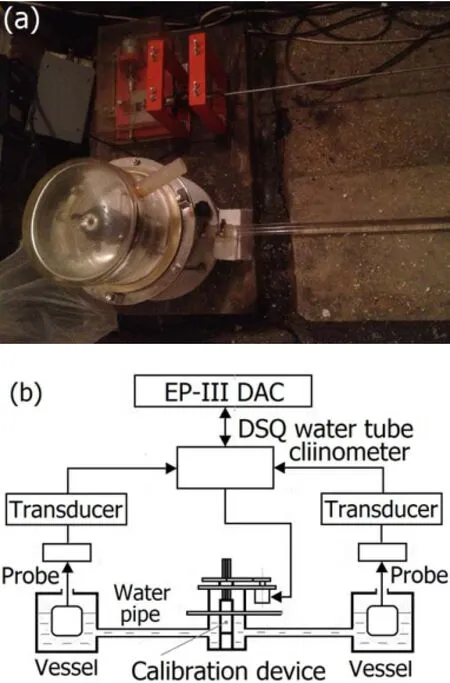
Fig.3. (Color online)DSQ water tube clinometer(a)and its schematics(b).
DSQ system has been used in tilt tide observation in seismostation.In this paper,we report the series harmonic analysis of the data and contrastive analysis of tidal monitoring observations between HLS and DSQ,carried out at the Jingxian seismostation,Anhui,China.
II.HARMONIC ANALYSIS OF HLS AND DSQ DATA
A.HLS installation
A set of HLSs were installed in a cave at the Jingxian seismostation.The temperature and humidity there are stable,and the background noise is extremely low.Table 1 lists specifications of HLS installations at the seismostation.

TABLE 1.Specifications of HLS installations at Jingxian seismostation
B.Harmonic analysis of HLS data
For harmonic analysis,Fig.4 shows the height difference of sensor readings from 10/11/2012 to 26/01/2013.

Fig.4.(Color online)Height difference of sensor readings of the N-S(a)and E-W(b)segments.
1.Temperature compensation
Temperature compensation shall be made to the raw data. The temperature effect on the HLS readings can be compensated by Eqs.(2)–(4):
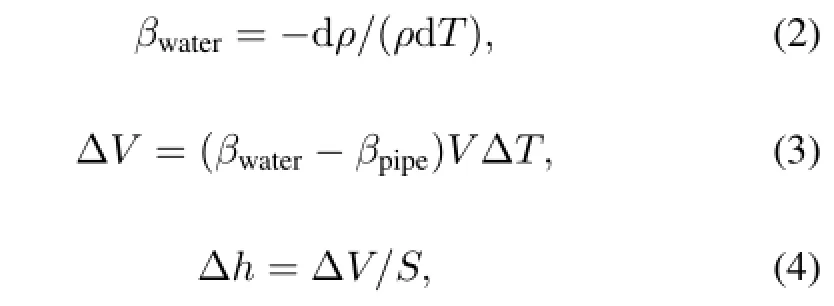
where,βwaterand βpipeare thermal expansion coefficient of water in the HLS vessels and the connecting pipe,respectively;T is the water temperature;ρ is the water density;ΔV is the change in water volume;ΔT is the temperature change; Δh is the height change in liquid level in the HLS vessels; and S is the internal cross-section of the vessel.Typically, Δh=-0.1mm/◦C.The negative value is due to different thermal expansion coefficients of water(2.5 10-4,25◦C), stainless steel(4.5 10-5)and PE pipe(4.5 10-4),respectively.
2.Data processing
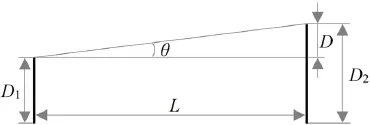
Fig.5.Conversion diagram.
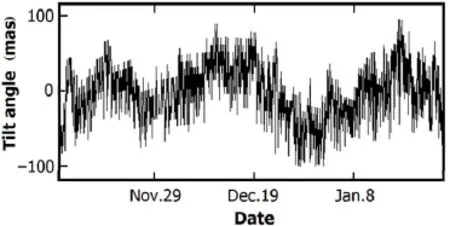
Fig.6.Tilt angles of the E-W segment from November 2012 to January 2013,obtained using the T-soft code.
Data handling,including linear and cubic interpolation, and multilinear regression,was done by using the T-soft code recommended by ICET(International Center for Earth Tides)[16].The tilt angle is very small(Fig.5),so the height difference could be converted into tilt angle using Eq.(5):

where,D1and D2are the data(in millimeter)measured from each sensor,L is the distance between the two monitoring sites(in meter),and θ is the tilt angle(in mas,milliarcsecond).The tilt angles of the E-W segment are shown in Fig.6 using the T-soft code.
3. Results of harmonic analysis
Harmonic analysis of HLS data was completed using the Eterna code,which is the standard software recommended by ICET[17].The E-W and N-S tilt tidal factors of the semidiurnal and diurnal tidal waves are given in Table 2.Fig.7 shows the predicted tide from HLS data(N-S segment)after harmonic analysis.The influence of the tidal effects is about±1µm in 18.1m by converting the tilt angle to height difference.

TABLE 2.Results of the harmonic analysis on HLS data

Fig.7.Predicted tide from HLS data(N-S segment).

Fig.8.Partial data before and after multilinear regression(a)and the predicted tide from DSQ data(b),for the N-S segment.
C.Harmonic analysis of data from DSQ
DSQ water tube clinometers are installed on bedrock, which is very stable.The data before and after multilinear regression are partially shown in Fig.8(a)to reflect the tidal effects on the clinometers(in mas),with just the data of N-S segment.Fig.8(b)shows the predicted tide from DSQ data (N-S segment)after harmonic analysis.The E-W and N-S tilt tidal factors are listed in Table 3.
III.CONTRASTIVE ANALYSIS OF THE TILT TIDAL FACTOR
A.Damping constant of different instruments
According to Tables 2 and 3,the preliminary hypothesis is that the tilt tidal factors are related with the type of observation instruments,just as the frequency response does.And these influence factors should be investigated.
Considering the same principle of HLS and DSQ,both the instruments basically follow the Euler kinematical equation of the fluid:

where,ω0=[2sg/(SL)]1/2is the natural angular frequency, S and s are respectively the internal cross-section of the sensor and the water tube,g is the local gravitational acceleration,and L is the distance between the two monitoring sites; and ξ0=4πK/(sρω0)is the damping constant of the liquid surface vibration,D is the height difference between the real time height and the initial equilibrium height of the liquid surface,K and ρ are respectively the viscous coefficient and density of the liquid in the tube.
Assuming that the deviation value of the height difference in the beginning is D0,when t=0,dD/dt=0,D(0)=0, solution of Eq.(6)can be described as Eqs.(7)–(9):

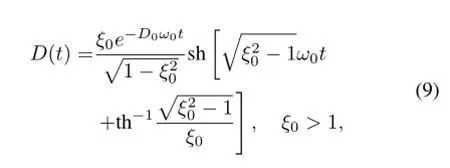
From Eqs.(7)–(9),influence of the damping constant on movement of the liquid surface is obvious:ξ0is related with parameters of S,L,K,s and ρ,and basically each of the parameters of HLS differs from that of DSQ.The damping constant of HLS[1]did differ from that of DSQ[18].Although the two instruments were installed in the same site (with the same tilt tide),the height difference D(t)between the real time height and the initial equilibrium height of the liquid surface is different,hence the different calculation results of tilt tidal factors.
B.Relations between damping constant and the frequency response of the instrument
Frequency response Q(T)of HLS and DSQ can be described as Eq.(10),where ξ0is the damping constant of the liquid surface vibration;α =T0/T is the cycle ration,T0is duty cycle of the instrument,and T is the cycle of ground motion.

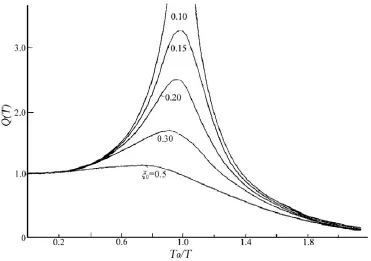
Fig.9.Frequency response curve.
Figure 9 shows the frequency response of the instrument. According to the design parameters of HLS at Jingxian seismostation,duty cycle of the instrument is 67s[1],which is smaller than the cycle of earth tide,the α value is almost zero, so Q(T)=1 in Fig.8(a),the tidal signal is not distorted at all.But if an earthquake or ground effect happened,sympathetic vibration would happen when the cycle of the disturbing signal is close to the duty cycle of the instrument. HLS differs from DSQ in their duty cycle and ξ0,hence the differentfrequencyresponseoftheinstruments.Fromtheraw data recorded by the two instruments,the sympathetic vibration phenomenon happened during the period,which might lead to different frequency domain signal distortion.This is another reason to explain the different results of harmonic analysis.

Fig.10.(Color online)The HLS locations(a),the HLS readings(b)and the predicted tide(c)at SPring-8 in 2006.

Fig.11.(Color online)Height difference and the relative tidal correction(a),and residual signal after tidal correction(b).
C.Results
According to the earth tide theory and Tables 2 and 3,the tilt tidal factor of M2is 0.68,the calculated tilt tidal factor from HLS of M2is 0.72582,and the value from DSQ is 0.80333.Based on the analysis above,the difference between the results of the tilt tidal factor is related with the type of observation instruments with different damping constants. In spite of a little difference between the tilt tidal factor of HLS and DSQ,but the amplitude of predicted tide of HLS data and DSQ data is the same according to Figs.7 and 8(b). Therefore,the tilt tide can be well reflected in the data of both instruments and both the results are reliable,and the method to treat the tilt tide effects on the reading of HLS is feasible.
IV.TIDAL CORRECTION TO THE HLS DATA USED IN SPRING-8 STORAGE RING
A validation study based on measurement data of the HLS used in particle accelerator for tidal correction on the HLS reading is necessary.A set of HLSs were installed in the SPring-8 storage ring,in Hyogo,Japan,as shown in Fig.10(a).The two HLSs,linked with pipes,were 146.4m apart.Two HLS readings during 1/1/2006 to 11/1/2006 are shown in Fig.10(b).The changing trend of the readings is well reflected.Through harmonic analysis to the data of HLS in SPring-8 storage ring,the local tilt tide model was calculated and predicted by the Eterna code.The results are shown in Fig.10(c).The tidal effects on the height difference between the two HLSs are shown in dashed line in Fig.11(a), and subtracting the residual signal after tidal correction from the height difference,the ground deformation is obtained,as shown in Fig.11(b).
It is known that the earth tide does not affect the straightness of accelerator alignment,but it changes inclination of the whole system.So,the tidal effects on the HLS readings must be corrected,otherwise it will cause alignment errors in the particle accelerator.According to Fig.11(a),the maximum amplitude of tilt tide model is±0.038mm,in other words, theabsoluteinfluenceofthetidaleffectsis0.076mmin146.4 meters,hence the non-negligibility of the tidal effects on the HLS readings.Due to the research on the tidal effects on HLS,relatedcomponentsoftheacceleratorareworkingproperly,and accuracy of the alignment is improved.
V.SUMMARY
Itisknownthatthemain goalfortheprocessing ofthe HLS measurements is therefore to isolate the local ground deformations from the raw measurement signal.Two different instruments to determining the ground deformations have been tried.Based on the data recorded by HLS and DSQ,and the contrastive analysis of the harmonic results,the tilt tide can be well reflected in the data of the two instruments.So the method discussed in this paper to handle the tidal effects on the readings of HLS can be proved to be feasible and reliable,the local ground deformations are obtained by deleting the tide effects on the readings of the instruments.Then the validation study based on the measurement data of the HLS used in Spring-8 storage ring for tidal correction on the reading of HLS is completed,and the maximum amplitude of the tidal effects on the readings of HLS is obtained.Obviously, the accuracy of alignment with using HLS is improved.It can be concluded that HLS application in micron-level precision alignment of particle accelerators is achievable.
ACKNOWLEDGEMENTS
The authors would like to thank the staffs of Earthquake Administration of Anhui Province,Jingxian Seismostation and SPring-8 in Hyogo,for their consistent support.
[1]He X Y and He X H.J Geodesy Geodyn,2007,27:122–124. (in Chinese)
[2]Roux D.in Proceedings of IWAA1989,SLAC,Stanford University,1989,37–72.
[3]He X Y.Chinese J Nucl Sci Eng,2006,26:332–333.(in Chinese)
[4]Martin D and Roux D.in Proceedings of IWAA1990,Hamburg,Germany,1990,171–181.
[5]Martin D.in Proceedings of EPAC1992,Berlin,Germany,1992,141–143.
[6]Gatta G,Levet N,Martin D.in Proceedings of IWAA1999, Grenoble,France,1999.
[7]Martin D.in Proceedings of The 22nd Advanced ICFA Beam Dynamics Workshop on Ground Motion in Future Accelerators,SLAC,USA,2000,341–357.
[8]He X Y,Huang K X,Chen S Y,et al.Nucl Tech,2007,30: 486–487.(in Chinese)
[9]He X Y and Wu J.Nucl Tech,2010,33:326–327.(in Chinese)
[10]He X Y.Latest Developments and Applications of Hydrostatic Levelling System.Hefei(China):USTC press,2010.(in Chinese)
[11]He X Y,Wang J H,Chen Q T,et al.in Proceedings of IWAA 2008,KEK,Tsukuba,Japan.2008.
[12]Mark J.in Proceedings of IWAA 2010,DESY,Hamburg,Germany,2010.
[13]Seryi A,Ruland R E,Baklakov B,et al.in Proceedings of PAC2001,IEEE,2001,2:1479–1481.
[14]Nie L,Wen X W,Yi Z C,et al.Crustal Deformation Earthq, 2001,21:74–81.(in Chinese)
[15]Zheng Z F and Zhou D J.Seismol Geomagnetic Observation Res,2006,27:52–56.(in Chinese)
[16]Van Camp M and Vauterin P.Comput Geosci,2005,31:631–640.
[17]Wenzel H G.Bull Inf Mar´ees Terrestres,1996,124:9425–9439.
[18]Zhou Y Y,Wu T,Wen X W,et al.J Geodesy Geodyn,2010, 30:99–101.(in Chinese)
(Received November 22,2013;accepted in revised form February 21,2014;published online July 11,2014)
10.13538/j.1001-8042/nst.25.040102
∗Supported by the National Natural Science Foundation of China(No. 11075151)and Ph.D.Program Foundation of Ministry of Education of China(No.20123402110002)
†Corresponding author,xyhe@ustc.edu.cn
猜你喜欢
杂志排行
Nuclear Science and Techniques的其它文章
- Development of a beta radioluminescence nuclear battery∗
- Apparatus for determining permeability of hydrogen isotopes in molten-salt
- A facile method to build a proton nanosensor with neutral to basic pH sensitive range∗
- The flow characteristics of fluid in micro-channels of different shapes∗
- Hadron multiplicities in p+p and p+Pb collisions at the LHC∗
- An investigation on neutron induced reactions on stable CNO isotopes∗
